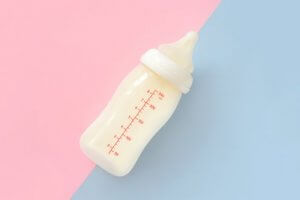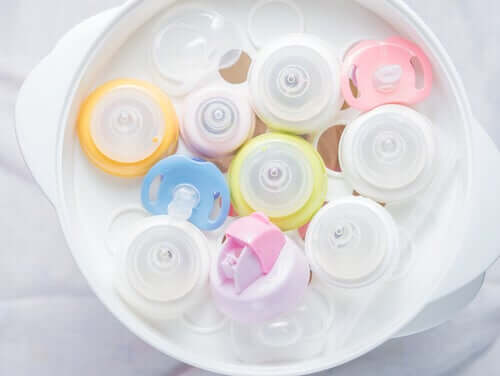Cronobacter Infection in Baby Milk

Cronobacter infection is one of the most serious infections a baby can get, and can be caused by poor bottle and teat hygiene. Because it can be fatal, it’s extremely important to always correctly sterilize baby bottles regularly.
We’re talking here about a rare infection caused by Cronobacter sakazakii bacteria. It usually affects newborn babies, as they have the lowest defenses, and their immune system still isn’t well-developed.
The causes of Cronobacter infection
Because of its ability to encapsulate the cells it creates, this bacterium is immune to antibiotics or antibodies, hence the seriousness of the matter when the baby contracts this infection.
Other characteristics of Cronobacter bacteria worth mentioning are that they expand and reproduce very easily due to their composition. All these factors make it a very complex bacterium to treat.

What symptoms can Cronobacter infection cause?
Meningitis
This bacteria is able to reach the lining around the brain, which is a protective barrier between the brain and the germs in the blood. If the germs manage to penetrate this lining then it can lead to meningitis, the symptoms of which are fever, headache, and a stiff neck.
The consequences of meningitis in such young children are severe. This is the most serious symptom that we’ll discuss.
Necrotizing Enterocolitis
Necrotizing Enterocolitis is another disease that can be caused by Cronobacter infection, and results in an inflammation of the baby’s colon. Symptoms of Cronobacter infection in this case include refusal of food, loose stools, and vomiting.
Sepsis
Sepsis is a serious disease. It occurs when the body’s immune system responds to the bacterial infection, as is the case here.
The body releases chemicals into the blood in order to remove the infection. As a result, there’s often a general inflammation and blood clots can occur. Because the blood can’t flow properly, the organs don’t receive all the nutrients they need and may begin to fail.

How can I prevent this type of infection?
There are some measures that are effective in preventing Cronobacter infection. The best preventive measure is breastfeeding, which helps the immune system become stronger and keeps infections at bay.
However, sometimes breastfeeding isn’t an option for the mother, and she has to use a bottle. In these cases, you can use the following measures that we’re going to share with you:
- Use liquid formula milk, whenever possible, rather than powdered.
- If you choose to heat the milk, never use the microwave. And, before giving it to your baby, check the temperature by placing a couple of drops on your wrist.
- Wash your hands with soap and water before and after touching your baby, and preparing and giving the formula milk or other foods.
- Clean and disinfect bottles and teats every time they’re used, as well as breast pumps and all other utensils. Sterilization is essential and helps prevent all kinds of infections, not just Cronobacter.
- Don’t store your baby’s items in a damp place, as this is an ideal environment for bacteria and other microorganisms to grow. This is especially the case if the utensils haven’t been dried correctly.
- If the baby doesn’t finish the whole bottle, throw away the milk after 2 hours. If you make the bottle, but the baby isn’t going to drink it immediately, then keep it in the fridge to prevent or delay the appearance of microbes.
- You can use tap water to make the milk powder, but you must first boil it for about 3 minutes.
Formula milk should only be used for 2 hours after preparation. If more than two hours pass without using the bottle, then you should discard it and prepare another bottle.
Prevention is key
As you’ve seen, prevention plays a key role in preventing many serious consequences for the baby’s health. These are not exaggerations, but necessary rigorous measures that arise from the need to protect your child’s vulnerable body and organs.
Cronobacter infection is one of the most serious infections a baby can get, and can be caused by poor bottle and teat hygiene. Because it can be fatal, it’s extremely important to always correctly sterilize baby bottles regularly.
We’re talking here about a rare infection caused by Cronobacter sakazakii bacteria. It usually affects newborn babies, as they have the lowest defenses, and their immune system still isn’t well-developed.
The causes of Cronobacter infection
Because of its ability to encapsulate the cells it creates, this bacterium is immune to antibiotics or antibodies, hence the seriousness of the matter when the baby contracts this infection.
Other characteristics of Cronobacter bacteria worth mentioning are that they expand and reproduce very easily due to their composition. All these factors make it a very complex bacterium to treat.

What symptoms can Cronobacter infection cause?
Meningitis
This bacteria is able to reach the lining around the brain, which is a protective barrier between the brain and the germs in the blood. If the germs manage to penetrate this lining then it can lead to meningitis, the symptoms of which are fever, headache, and a stiff neck.
The consequences of meningitis in such young children are severe. This is the most serious symptom that we’ll discuss.
Necrotizing Enterocolitis
Necrotizing Enterocolitis is another disease that can be caused by Cronobacter infection, and results in an inflammation of the baby’s colon. Symptoms of Cronobacter infection in this case include refusal of food, loose stools, and vomiting.
Sepsis
Sepsis is a serious disease. It occurs when the body’s immune system responds to the bacterial infection, as is the case here.
The body releases chemicals into the blood in order to remove the infection. As a result, there’s often a general inflammation and blood clots can occur. Because the blood can’t flow properly, the organs don’t receive all the nutrients they need and may begin to fail.

How can I prevent this type of infection?
There are some measures that are effective in preventing Cronobacter infection. The best preventive measure is breastfeeding, which helps the immune system become stronger and keeps infections at bay.
However, sometimes breastfeeding isn’t an option for the mother, and she has to use a bottle. In these cases, you can use the following measures that we’re going to share with you:
- Use liquid formula milk, whenever possible, rather than powdered.
- If you choose to heat the milk, never use the microwave. And, before giving it to your baby, check the temperature by placing a couple of drops on your wrist.
- Wash your hands with soap and water before and after touching your baby, and preparing and giving the formula milk or other foods.
- Clean and disinfect bottles and teats every time they’re used, as well as breast pumps and all other utensils. Sterilization is essential and helps prevent all kinds of infections, not just Cronobacter.
- Don’t store your baby’s items in a damp place, as this is an ideal environment for bacteria and other microorganisms to grow. This is especially the case if the utensils haven’t been dried correctly.
- If the baby doesn’t finish the whole bottle, throw away the milk after 2 hours. If you make the bottle, but the baby isn’t going to drink it immediately, then keep it in the fridge to prevent or delay the appearance of microbes.
- You can use tap water to make the milk powder, but you must first boil it for about 3 minutes.
Formula milk should only be used for 2 hours after preparation. If more than two hours pass without using the bottle, then you should discard it and prepare another bottle.
Prevention is key
As you’ve seen, prevention plays a key role in preventing many serious consequences for the baby’s health. These are not exaggerations, but necessary rigorous measures that arise from the need to protect your child’s vulnerable body and organs.
All cited sources were thoroughly reviewed by our team to ensure their quality, reliability, currency, and validity. The bibliography of this article was considered reliable and of academic or scientific accuracy.
- Alcover Bloch, E; García-Tornel, S. La esterilización de biberones, tetinas ya gua: ¿por qué hacemos trabajar a las madres más de la cuenta? An Esp Pediatr 1996; 44: 524525. [En línea] Disponible en: https://www.aeped.es/sites/default/files/anales/44-5-32.pdf
- Luján Medina, G. A., Loredo Treviño, A., & Noe Aguilar, C. (2014). Cronobacter sakazakii: Un Patógeno Emergente Transmitido por Alimentos. Revista Científica de La Universidad Autónoma de Coahuila.
- La alimentación segura del bebé: recomendaciones básicas para la inocuidad de la alimentación de los lactantes. ANMAT. [En línea] Disponible en: http://www.anmat.gov.ar/Alimentos/Recomendaciones_Formulas_Infantiles.pdf
This text is provided for informational purposes only and does not replace consultation with a professional. If in doubt, consult your specialist.








